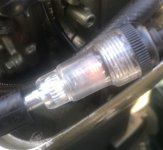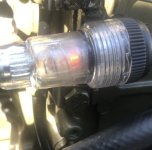patiolatern
Regular Contributor
10R74S 9.9. ……could be a long one
Rebuilt carb 6 weeks ago with OEM kit started well and ran in barrel. Adjusted lean/rich mixture at the time and no issues in barrel. Have not run it on water until this weekend.
Went out trolling and started the 9.9 rather then run my 70hp. The 9.9 seemed to push a lot of air bubbles and it seemed slow or having a harder time pushing the boat-16 ft aluminum bow rider.
It shut down after 30 minutes and could not get it started. Took the plugs out and the bottom plug was completely black with spit/carbon. The top plug seemed fine.
Today I checked a few things:
Compression is 120 on both cylinders
Spark was strong on both cylinders
Fuel pump was replaced over a year ago so I took it apart and it appears fine.
Checked spark plugs with ohm reading and seems fine
Switched fuel tanks to rule that as an issues for testing today
It was hard to start and keep running but I was able to and put it into gear. Seemed to run below normal levels at WOT. Run for a bit and then would stall out. Checked plugs and I think the top one had all black on it but I sort of lost track on what plug was where so not 100% sure. Cleaned spark plugs and ram it a few more times still hard to start and still stalls out. Tried another set of plugs and same issues.
Had a cheap tachometer on the bottom cylinder but it would not pick up a reading. Switched it to the top cylinder and was getting a reading of around 3500rpm. I also took then plug wire off the bottom cylinder while running and it didn’t run any worse. I did not get a chance to do this to the top cylinder.
Put a temperature sensor to the engine while running and it seems the top cylinder was getting warmer but the bottom cylinder lagged behind by a significant amount.
Not sure what this points to and what I can further diagnose to get to the issue and get this running right.
Is it my lean rich screw? Such a pain to start and keep running it’s hard to try different things. I would like to confirm all the problems are on the bottom cylinder but I can’t until it runs a little longer?
Would a bad coil cause this(even with strong spark)?
Any ideas or help is appreciated!!
Oh yeah….thanks for reading this long ass text.
Edit: My barrel water had a lot of black film in it.
Rebuilt carb 6 weeks ago with OEM kit started well and ran in barrel. Adjusted lean/rich mixture at the time and no issues in barrel. Have not run it on water until this weekend.
Went out trolling and started the 9.9 rather then run my 70hp. The 9.9 seemed to push a lot of air bubbles and it seemed slow or having a harder time pushing the boat-16 ft aluminum bow rider.
It shut down after 30 minutes and could not get it started. Took the plugs out and the bottom plug was completely black with spit/carbon. The top plug seemed fine.
Today I checked a few things:
Compression is 120 on both cylinders
Spark was strong on both cylinders
Fuel pump was replaced over a year ago so I took it apart and it appears fine.
Checked spark plugs with ohm reading and seems fine
Switched fuel tanks to rule that as an issues for testing today
It was hard to start and keep running but I was able to and put it into gear. Seemed to run below normal levels at WOT. Run for a bit and then would stall out. Checked plugs and I think the top one had all black on it but I sort of lost track on what plug was where so not 100% sure. Cleaned spark plugs and ram it a few more times still hard to start and still stalls out. Tried another set of plugs and same issues.
Had a cheap tachometer on the bottom cylinder but it would not pick up a reading. Switched it to the top cylinder and was getting a reading of around 3500rpm. I also took then plug wire off the bottom cylinder while running and it didn’t run any worse. I did not get a chance to do this to the top cylinder.
Put a temperature sensor to the engine while running and it seems the top cylinder was getting warmer but the bottom cylinder lagged behind by a significant amount.
Not sure what this points to and what I can further diagnose to get to the issue and get this running right.
Is it my lean rich screw? Such a pain to start and keep running it’s hard to try different things. I would like to confirm all the problems are on the bottom cylinder but I can’t until it runs a little longer?
Would a bad coil cause this(even with strong spark)?
Any ideas or help is appreciated!!
Oh yeah….thanks for reading this long ass text.
Edit: My barrel water had a lot of black film in it.



